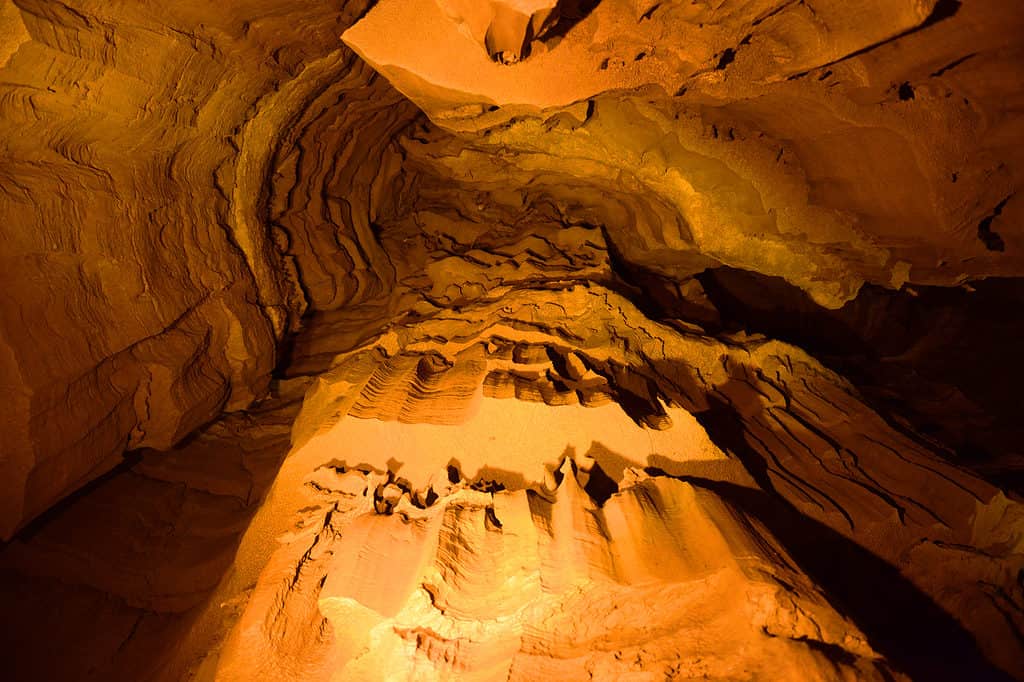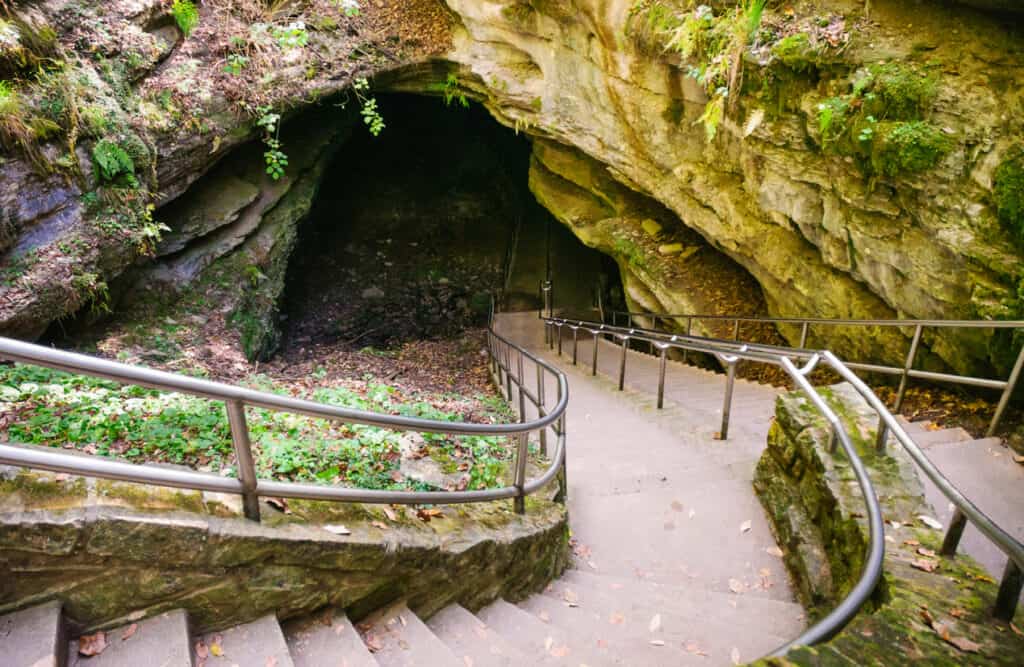There are many natural wonders worth seeing in this world, whether you want to see bodies of water, spacious forests, or the highest mountains. One category of natural wonders that people often overlook is underground caves. These labyrinths can be absolutely massive, as is the case with Mammoth Cave.
If you take a trip to Mammoth Cave, there is no way that you would be able to explore all of it on your first trip. You might wonder, how big is Mammoth Cave? If you want to learn the answer to this question, as well as more about this amazing cave system, keep reading!
Where Is Mammoth Cave?
Mammoth Cave is located under Mammoth Cave National Park, which is in west-central Kentucky. The 52,830 acres of space in this park are mostly located in Edmonson County, with extensions into the Barren and Hart counties to the east.
The declared purpose of Mammoth Cave National Park is to preserve and study the features and processes associated with the underlying cave system, as well as all of the natural aboveground surroundings.

Mammoth Cave is located in Mammoth Cave National Park in Kentucky and is the world’s largest cave known to mankind.
©Wangkun Jia/Shutterstock.com
How Big Is Mammoth Cave?
Mammoth Cave is the world’s longest cave, as far as humans know. Currently, explorers have mapped out 426 miles of the cave system. Explorers discover several miles almost every year. Scientists estimate that there may be as many as 600 more miles of the cave that no one has seen!
The truth is that we actually don’t know exactly how big Mammoth Cave is. Scientists and explorers have not yet found its end, even after all of the passageways that they have found and mapped. It may be much bigger than we currently believe!
As far as we know, Mammoth Cave is almost twice as long as its runner-up, which is the Sac Actun underwater cave in Mexico.
Mammoth Cave National Park, above ground, encompasses about 80 square miles of space. More than 200 caves in the park are disconnected fragments of the larger cave system.
How Mammoth Cave Became Known as the World’s Longest Cave System
Humans have been going into Mammoth Cave for thousands of years, starting with prehistoric American Indians about five millennia ago. In the 1800s and 1900s, Mammoth Cave guides explored and mapped the passageways of the cave system. They did not know at the time that they were exploring the longest cave system in the world.
Initially, it was Flint Ridge Cave that explorers thought was the longest cave system in the world, with 86.5 miles of mapped passageways. In the 1950s and 1960s, they found four cave systems to be connected and identified them as part of Flint Ridge. This was just one ridge over from Mammoth Cave, which explorers at that time thought was 57.9 miles long.
For years, explorers tried to find a connection between the two to show that it was just one system, to no avail.
However, in September 1972, all of this changed. A team of six entered the Austin entrance of the Flint Ridge Cave system. Expecting the passage to siphon off, the group leader was shocked when he actually saw that it opened into a large space. This was actually Mammoth Cave, proving that it was all just one enormous cave system!

The truth is that humans don’t actually know how big Mammoth Cave is.
©Wangkun Jia/Shutterstock.com
How Did Mammoth Cave Form?
Cave systems form when limestone dissolves. Rainwater pulls carbon dioxide from the air, and the solution turns into a weak acid as it percolates through the soil. This acid very gradually dissolves limestone under the soil. In some cases, cracks will form, and some of these become large enough to form caves.
Mammoth Cave developed within thick limestone strata, which were topped with a layer of sandstone. The upper sandstone layer has been given the name Big Clifty Sandstone. This combination has made the cave system extremely stable compared to many others.
Big Clifty Sandstone actually has very thin layers of limestone embedded within it. These form an epikarst zone. Groundwater enters tiny passages within these zones, which concentrate the runoff into springs at the edges of the ridges above ground.
This water will flow along the surface before sinking back underground at the level between the sandstone and the huge underlying mass of limestone. This is where the cave system is formed. The natural acidity of the water very gradually erodes away at the limestone to create large spaces.
There are different limestone layers beneath the upper sandstone layer. These are, in increasing depth underground, the Girkin Formation, the Ste. Genevieve Limestone, and the St. Louis Limestone. The main cave passage that visitors can see on the historic tour is located between the first two layers.
There are many locations within the cave system where water has eroded through the sandstone layer above. However, overall, it is pretty difficult for water to penetrate the sandstone layer except at sites of vertical cracks. Because of this, in much of the cave, there are no stalactites, stalagmites, or any other formations that require dripping water from above to develop.

People use the trails to discover how big Mammoth Cave is during tours.
©iStock.com/zrfphoto
Animals in Mammoth Cave
Mammoth Cave is the residence of many different animals. You may see them either exploring the surface area of Mammoth Cave National Park or the cave itself.
Above ground, you are likely to see common animals. These include salamanders, snakes, eastern gray squirrels, white-tailed deer, wild turkeys, songbirds, and more. If you are looking into the waterways, you’ll see all sorts of freshwater fish as well. This is one of the most diverse ecosystems in the United States, with over 1,300 flowering species in addition to all the animals.
We know of nearly 160 animal species that actually live within the cave system. Some of these species are cave salamanders, eyeless fish, sheep-nose mussels, and the Kentucky cave shrimp (an endangered species).
There are 14 species of troglobites in this cave. These are species that have specifically adapted to life inside of a cave. For example, Rafinesque big-eared bats, Allegheny woodrats, and cave crickets have developed their senses so that they can survive and thrive within the dampness and darkness of the cave system.
There are also many troglophiles, which can live either in or outside of a cave.
Where Is Mammoth Cave Located On a Map?
Mammoth Cave is found on a map in the southwestern portion of Kentucky in the heart of Mammoth Cave National Park. The River Styx Spring is found directly to the west of the cave’s exact location, and Nolin Lake State Park can be seen to the north of Mammoth Cave National Park.
The photo featured at the top of this post is © Ko Zatu/Shutterstock.com
Thank you for reading! Have some feedback for us? Contact the AZ Animals editorial team.






